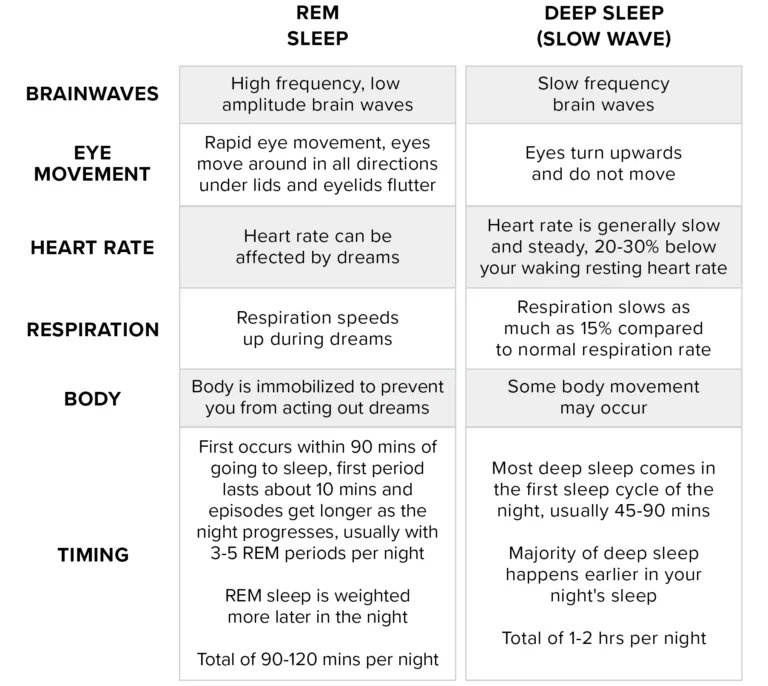Topics
- Article
- Sleep
Deep Sleep vs. REM Sleep: What are the Differences?

Deep sleep and REM sleep are two very different stages of sleep with distinct characteristics that support your body and mind in specific ways.
Deep sleep and REM sleep are both important stages in the sleep cycle, but they support your body and mind in distinct ways and have different identifying features. You can track how much Deep sleep vs. REM sleep you’re getting each night to better understand the quality of your sleep.
Deep Sleep vs. REM Sleep
There is often confusion between deep sleep and REM sleep, despite their differences. Deep sleep, also known as the "physically restorative" stage of sleep, is when your muscles and tissues repair themselves while your cells regenerate. This stage is responsible for the production of 95% of human growth hormone. REM sleep, on the other hand, is the "mentally restorative" stage of sleep where your brain converts short-term memories into long-term ones. During REM sleep, your brain is highly active, hence the name "rapid eye movement", and your heart rate and respiratory rate increase. This stage is also associated with experiencing vivid dreams.
Deep Sleep Characteristics
Deep sleep is the second stage of sleep, after light sleep. Deep sleep is characterized by a slow, steady heart rate and slow respiratory rate. In deep sleep your heart rate may be 20-30% slower than your waking resting heart rate and your respiratory rate can slow as much as 15% compared to your normal waking breathing rate. Additionally, your body may move during this stage of sleep and your eyes turn upwards under their lids. Brain waves are the slowest during deep sleep. This is the reason it’s also called slow wave sleep (SWS). Deep sleep is the stage where the body restores itself physically. Blood flow increases to help repair muscles and bones, balance metabolism and blood sugar levels, and strengthen the immune system.

REM and deep sleep have distinct characteristics Including brainwaves, heart rate and respiratory rate.
REM Sleep Characteristics
Rapid eye movement or REM sleep is identified by movement of the eyes under their lids. This is the stage when you may experience vivid narrative dreams that can increase your heart rate and respiratory rate. Your body temperature may also fluctuate. Brain activity in REM sleep is similar to when you’re conscious. During REM sleep your body becomes relaxed and immobile as your brain sends signals to the spinal cord to shut off movement. This creates temporary paralysis in the arms and legs, to avoid the body acting out your dreams. Sleepwalking may happen when this temporary paralysis is disrupted. Sleep apnea may also be worse during REM sleep because the muscles relax so much. Sleep scientists believe REM sleep is involved in learning, storing memories, and balancing mood. It may heal and restore the brain similarly to the way deep sleep heals and restores the body, preparing both for the day to come. For athletes, it is involved in committing new technical skills to long-term memory.
How Much REM Sleep and Deep Sleep Do You Need?
You normally enter deep sleep between 30 minutes and an hour after falling asleep. Your first period of deep sleep usually lasts 45-90 minutes, but time spent in deep sleep generally becomes shorter in the sleep cycles later in the night. The first period of REM sleep usually occurs within 90 minutes of going to sleep. It usually lasts about 10 minutes and episodes get longer as the night processes. The average adult goes through 3-5 full sleep cycles per night typically, totaling 1-2 hours of deep sleep and 90-120 minutes of REM sleep.
Track How Much Sleep You’re Getting With WHOOP
Monitoring your sleep with WHOOP lets you see how much sleep you get on a nightly basis and how different variables affect your sleep. WHOOP tracks your sleep each night and breaks down precisely how much time you spend in each stage of sleep. The WHOOP app Sleep Planner recommends bed and wake times based on your personal circadian rhythm to help you maximize every stage of sleep.